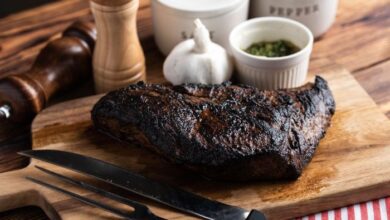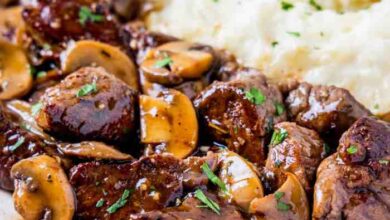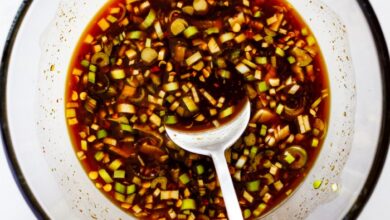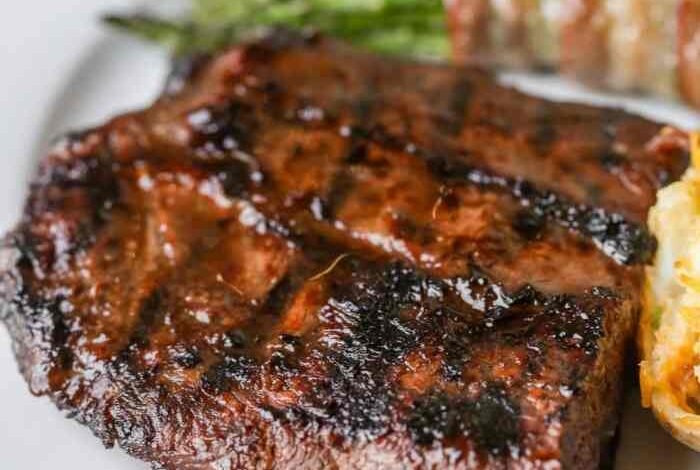
The Best Steak Marinade: Secrets to Tender, Flavorful Perfection
The best steak marinade is more than just a flavorful bath – it’s a culinary alchemy that transforms a simple cut of meat into a masterpiece. From understanding the nuances of different steak cuts to mastering the art of marinade techniques, this guide will equip you with the knowledge and recipes to create steak so tender, juicy, and flavorful, it’ll have your taste buds singing.
We’ll explore the essential ingredients that make a marinade truly exceptional, delve into various flavor profiles to cater to every palate, and share foolproof recipes that will elevate your grilling game. Whether you’re a seasoned steak enthusiast or a beginner looking to impress, this comprehensive guide will lead you to steak perfection.
Understanding Steak Cuts
Choosing the right cut of beef is crucial for a successful marinade. Different cuts have varying levels of tenderness, marbling, and connective tissue, which affect their ability to absorb flavors and their overall texture after cooking.
Types of Steak Cuts for Marinating
The type of cut you choose will significantly impact the final result of your marinade. Here are some popular steak cuts suitable for marinating, along with their characteristics and recommended marinade types:
- Flank Steak:This cut is known for its robust flavor and lean texture. It’s a great option for marinating due to its relatively thin shape, which allows for maximum flavor absorption.
Recommended Marinades:
– Citrus-based marinades:Lemon, lime, and orange juice tenderize the meat and provide a bright, tangy flavor.
– Soy-based marinades:Soy sauce, ginger, and garlic create a savory and umami-rich flavor profile.
– Spicy marinades:Chili peppers, paprika, and cumin add heat and depth to the flank steak.
The best steak marinade is a matter of personal preference, but I always find that a simple combination of garlic, olive oil, and herbs works wonders. To complement the richness of a perfectly grilled steak, I love serving it alongside a morel mushroom and wild rice risotto.
The earthy flavors of the mushrooms and the nutty notes of the wild rice provide a delicious contrast to the savory steak, creating a truly satisfying meal.
- Skirt Steak:Similar to flank steak, skirt steak is a flavorful and lean cut. It has a long, thin shape and is often used in fajitas. Marinating helps to tenderize the meat and enhance its flavor.
Recommended Marinades:
– Tex-Mex marinades:Lime juice, cilantro, cumin, and chili powder are common ingredients in Tex-Mex marinades that complement the skirt steak’s bold flavor.
– Asian-inspired marinades:Soy sauce, ginger, garlic, and sesame oil create a savory and aromatic marinade that enhances the skirt steak’s flavor.
- Top Sirloin:This cut is known for its tender texture and rich flavor. It’s a good choice for marinating as it can benefit from the additional moisture and flavor.
Recommended Marinades:
– Herb-based marinades:Rosemary, thyme, oregano, and garlic create a flavorful and aromatic marinade that complements the top sirloin’s natural taste.
– Wine-based marinades:Red wine, balsamic vinegar, and herbs create a rich and complex marinade that enhances the top sirloin’s flavor.
- Rib-eye:This cut is renowned for its marbling and rich flavor. While it’s already tender, marinating can enhance its flavor and create a more flavorful and juicy steak.
Recommended Marinades:
– Simple marinades:Salt, pepper, and olive oil are sufficient to enhance the rib-eye’s natural flavor.
Finding the perfect steak marinade is a bit like searching for the holy grail of grilling – it’s a quest! While I’m on the hunt for that ultimate flavor bomb, I’ve found a great way to satisfy my craving for comfort food: a quick and easy chicken spaghetti.
This recipe from Cerita Kuliner is a lifesaver on busy nights. But don’t worry, my steak marinade search continues – I’ll keep you posted on my discoveries!
– Garlic-based marinades:Garlic, olive oil, and herbs create a flavorful and aromatic marinade that complements the rib-eye’s richness.
Essential Marinade Ingredients: The Best Steak Marinade
A marinade is a flavorful liquid that infuses your steak with deliciousness. A good marinade not only adds taste but also tenderizes the meat. It’s a key element for achieving a mouthwatering steak that’s both juicy and flavorful.
Key Ingredients and Their Roles
The most effective marinades utilize a blend of ingredients, each playing a crucial role in achieving a perfect steak.
Acids
Acids are essential for tenderizing the meat by breaking down tough proteins. This allows the marinade to penetrate deeper into the steak, resulting in a more flavorful and tender end product.
Common Acids:
- Vinegar (apple cider, white, red wine)
- Lemon juice
- Lime juice
- Yogurt
- Buttermilk
Oils
Oils contribute to the marinade’s texture and act as a carrier for the other ingredients. They also help to prevent the steak from drying out during cooking.
I’m always looking for new ways to elevate my grilling game, and lately, I’ve been obsessed with finding the perfect steak marinade. But sometimes, even the most delicious steak needs a sweet counterpoint, and that’s where my go-to dessert comes in: fresh apple cake ii.
The warm, cinnamon-spiced cake is the perfect way to end a meal featuring a perfectly seared steak.
Common Oils:
- Olive oil
- Canola oil
- Vegetable oil
- Sesame oil
Flavor Enhancers
Flavor enhancers add depth and complexity to the marinade. These ingredients create a symphony of taste that elevates the steak’s overall profile.
Common Flavor Enhancers:
- Soy sauce
- Worcestershire sauce
- Fish sauce
- Honey
- Maple syrup
- Garlic
- Ginger
- Herbs (rosemary, thyme, oregano)
- Spices (black pepper, paprika, chili powder)
Tenderizers
Tenderizers, such as papaya or pineapple, contain enzymes that break down proteins, further contributing to a more tender steak.
Common Tenderizers:
- Papaya
- Pineapple
- Meat tenderizer (commercial product)
Ingredient Functions Table
| Ingredient | Function | Examples | Notes |
|---|---|---|---|
| Acids | Tenderize meat, enhance flavor | Vinegar, lemon juice, yogurt | Use in moderation to avoid making the steak too sour |
| Oils | Add texture, carry flavors, prevent drying | Olive oil, canola oil, sesame oil | Choose an oil with a high smoke point for grilling or pan-frying |
| Flavor Enhancers | Add depth and complexity to flavor | Soy sauce, garlic, ginger, herbs, spices | Experiment with different combinations to find your favorite profile |
| Tenderizers | Break down proteins, make meat more tender | Papaya, pineapple, meat tenderizer | Use sparingly, as excessive tenderizing can result in a mushy steak |
Marinade Techniques
The choice of marinade technique plays a significant role in the final flavor and tenderness of your steak. Each technique has its own advantages and disadvantages, influencing the level of flavor infusion, moisture retention, and overall cooking outcome.
Dry Rubs
Dry rubs are a simple and effective way to enhance the flavor of steak without adding excess moisture. They typically consist of a mixture of spices, herbs, and sometimes salt and sugar.Dry rubs are applied directly to the surface of the steak and allowed to sit for a period of time, allowing the flavors to penetrate the meat.
This technique is particularly effective for cuts of steak that are naturally tender, such as ribeye or tenderloin.
Benefits
- Flavor Infusion:Dry rubs provide a concentrated burst of flavor, as the spices and herbs adhere directly to the surface of the steak.
- Moisture Retention:While dry rubs don’t add moisture, they can help retain existing moisture by creating a flavorful crust that locks in juices during cooking.
- Versatility:Dry rubs can be customized to create a wide range of flavor profiles, from classic to exotic.
Drawbacks
- Limited Penetration:Dry rubs primarily impact the surface of the steak, with limited penetration into the interior.
- Short Marinating Time:Dry rubs typically require shorter marinating times compared to wet marinades.
Optimal Marinating Time
The optimal marinating time for dry rubs varies depending on the thickness of the steak and the desired level of flavor infusion. Generally, a dry rub can be applied anywhere from 30 minutes to 4 hours before cooking. For thicker cuts, a longer marinating time may be necessary.
Wet Marinades
Wet marinades are liquid-based mixtures that typically contain oil, acid, and aromatics. They work by tenderizing the meat and infusing it with flavor.Wet marinades are ideal for tougher cuts of steak, such as flank steak or skirt steak, as the acid in the marinade helps to break down the muscle fibers and make the meat more tender.
Benefits
- Tenderization:The acid in wet marinades helps to break down the tough muscle fibers in steak, resulting in a more tender texture.
- Deep Flavor Infusion:Wet marinades penetrate the meat more deeply than dry rubs, delivering a more intense flavor profile.
- Moisture Retention:The oil in wet marinades helps to prevent the steak from drying out during cooking.
Drawbacks
- Over-Marinating:Marinating steak for too long in a wet marinade can lead to a mushy texture, as the acid breaks down too much of the muscle fibers.
- Flavor Dilution:Wet marinades can sometimes dilute the natural flavor of the steak.
Optimal Marinating Time
The optimal marinating time for wet marinades depends on the cut of steak and the desired level of tenderness. For tougher cuts, a longer marinating time of 4-8 hours is recommended. For more tender cuts, a shorter marinating time of 1-2 hours may suffice.
Brining
Brining is a technique that involves soaking meat in a salt-water solution. This process helps to retain moisture and enhance the flavor of the steak.Brining is particularly effective for cuts of steak that are naturally lean, such as sirloin or top round, as it helps to prevent them from drying out during cooking.
Benefits
- Moisture Retention:Brining draws moisture into the steak, resulting in a juicier and more flavorful final product.
- Improved Tenderness:Brining can also help to improve the tenderness of the steak, as the salt helps to break down the muscle fibers.
Drawbacks
- Limited Flavor Infusion:Brining primarily focuses on moisture retention and tenderness, with limited impact on flavor.
- Time-Consuming:Brining can be a time-consuming process, as it typically requires at least 4 hours, and sometimes up to 24 hours.
Optimal Marinating Time
The optimal brining time for steak is typically 4-8 hours. However, for thicker cuts or for a more intense flavor, a longer brining time of up to 24 hours may be used.
Flavor Profiles
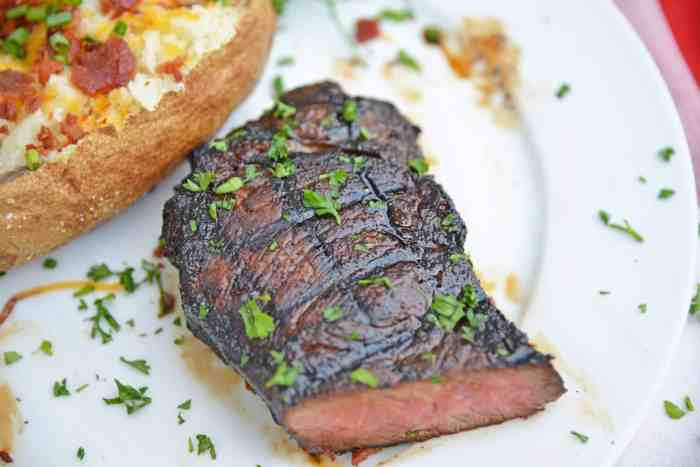
A steak marinade’s flavor profile is what sets it apart and makes it unique. The right marinade can elevate your steak from ordinary to extraordinary, infusing it with complex and delicious flavors. Exploring various flavor profiles allows you to experiment with different tastes and find the perfect marinade for your culinary preferences.
Classic Flavor Profiles
Classic flavor profiles are timeless and familiar, offering a balanced and satisfying taste. They often feature a combination of sweet, savory, and acidic notes, creating a harmonious blend that complements the natural flavor of the steak.
| Flavor Profile | Key Ingredients | Steak Cut Recommendation | Notes |
|---|---|---|---|
| Garlic Herb | Garlic, fresh herbs (thyme, rosemary, parsley), olive oil, lemon juice, salt, pepper | Rib-eye, New York Strip | This marinade enhances the natural flavor of the steak with a fragrant, herbaceous aroma. |
| Soy Ginger | Soy sauce, ginger, garlic, honey, sesame oil, black pepper | Flank Steak, Skirt Steak | This marinade adds a savory and slightly sweet flavor with a hint of ginger’s warmth. |
Bold Flavor Profiles
Bold flavor profiles are designed to pack a punch, featuring intense and assertive flavors that create a memorable dining experience. These marinades often incorporate strong spices, vinegars, or other ingredients that add depth and complexity to the steak.
| Flavor Profile | Key Ingredients | Steak Cut Recommendation | Notes |
|---|---|---|---|
| Chipotle Lime | Chipotle peppers in adobo sauce, lime juice, garlic, cumin, oregano | Sirloin, Tri-Tip | This marinade delivers a smoky, spicy kick with a tangy lime twist. |
| Bourbon Brown Sugar | Bourbon whiskey, brown sugar, Worcestershire sauce, garlic, black pepper | Ribeye, New York Strip | This marinade infuses the steak with a sweet and smoky flavor, balanced by the richness of the bourbon. |
Unique Flavor Profiles
Unique flavor profiles are designed to push the boundaries of traditional steak marinades, offering unexpected and intriguing taste combinations. These marinades may incorporate exotic spices, fruits, or other unconventional ingredients to create a truly distinctive flavor experience.
| Flavor Profile | Key Ingredients | Steak Cut Recommendation | Notes |
|---|---|---|---|
| Mango Habanero | Mango, habanero peppers, lime juice, cilantro, garlic, cumin | Flank Steak, Skirt Steak | This marinade combines the sweetness of mango with the heat of habanero peppers, creating a vibrant and spicy flavor. |
| Espresso Rub | Espresso powder, garlic powder, onion powder, paprika, chili powder, salt, pepper | Ribeye, New York Strip | This marinade adds a rich, earthy flavor with a hint of coffee’s bitterness. |
Steak Marinade Recipes
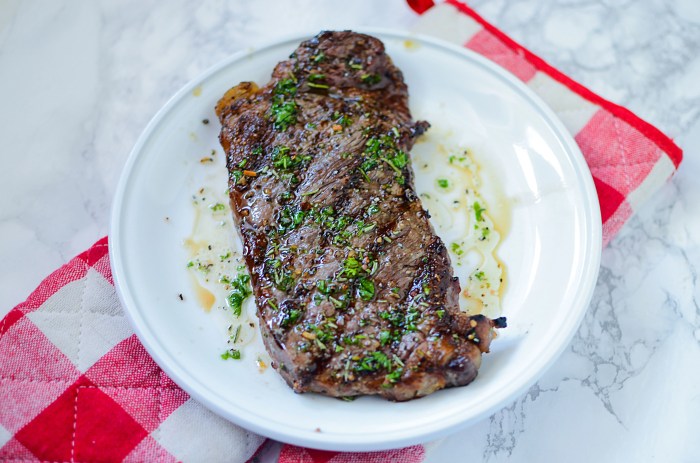
Now that you understand the fundamentals of steak cuts, marinade ingredients, techniques, and flavor profiles, let’s delve into some specific marinade recipes. These recipes are designed to showcase distinct flavor profiles and provide a foundation for you to experiment with your own creations.
Classic Herb Marinade, The best steak marinade
This marinade offers a balanced blend of savory, aromatic, and slightly tangy flavors. It’s perfect for grilling or pan-searing steaks, imparting a rich depth of flavor without overpowering the natural taste of the meat.
Ingredients
- 1/2 cup extra virgin olive oil
- 1/4 cup red wine vinegar
- 2 tablespoons chopped fresh rosemary
- 2 tablespoons chopped fresh thyme
- 2 cloves garlic, minced
- 1 teaspoon salt
- 1/2 teaspoon black pepper
Instructions
- In a small bowl, whisk together the olive oil, red wine vinegar, rosemary, thyme, garlic, salt, and pepper.
- Pour the marinade over the steak and ensure it’s completely coated.
- Cover and refrigerate for at least 2 hours, or up to 24 hours for maximum flavor infusion.
Tips
- This marinade is particularly well-suited for ribeye, New York strip, and filet mignon steaks.
- For a more intense flavor, consider using a combination of fresh and dried herbs.
- For a smoky flavor, add a pinch of smoked paprika to the marinade.
Spicy Chipotle Marinade
This marinade delivers a fiery kick with a hint of smokiness. It’s ideal for adding a bold and complex flavor to thicker cuts of steak like chuck roast or flank steak, making them incredibly tender and flavorful.
Ingredients
- 1/2 cup adobo sauce from canned chipotle peppers in adobo
- 1/4 cup lime juice
- 2 tablespoons olive oil
- 1 tablespoon honey
- 1 teaspoon cumin
- 1 teaspoon smoked paprika
- 1/2 teaspoon garlic powder
- 1/4 teaspoon cayenne pepper (adjust to your desired spice level)
- 1/4 teaspoon salt
- 1/4 teaspoon black pepper
Instructions
- In a blender or food processor, combine all ingredients and blend until smooth.
- Pour the marinade over the steak and ensure it’s completely coated.
- Cover and refrigerate for at least 4 hours, or up to 12 hours for maximum flavor infusion.
Tips
- This marinade is excellent for tougher cuts of steak that benefit from longer marinating times.
- For a milder spice level, omit the cayenne pepper or use a smaller amount.
- This marinade can also be used for chicken, pork, or fish.
Sweet and Savory Ginger-Soy Marinade
This marinade offers a delightful balance of sweet, savory, and slightly tangy flavors. It’s perfect for marinating thin cuts of steak like skirt steak or flank steak, creating a tender and flavorful dish ideal for stir-fries or grilling.
Ingredients
- 1/4 cup soy sauce
- 1/4 cup honey
- 2 tablespoons rice vinegar
- 2 tablespoons grated fresh ginger
- 1 tablespoon sesame oil
- 1 clove garlic, minced
- 1/2 teaspoon black pepper
Instructions
- In a small bowl, whisk together the soy sauce, honey, rice vinegar, ginger, sesame oil, garlic, and pepper.
- Pour the marinade over the steak and ensure it’s completely coated.
- Cover and refrigerate for at least 30 minutes, or up to 2 hours for maximum flavor infusion.
Tips
- This marinade is ideal for thin cuts of steak that cook quickly.
- For a more intense ginger flavor, use a larger amount of grated fresh ginger.
- This marinade can also be used for chicken, pork, or tofu.
Cooking Steak with Marinade
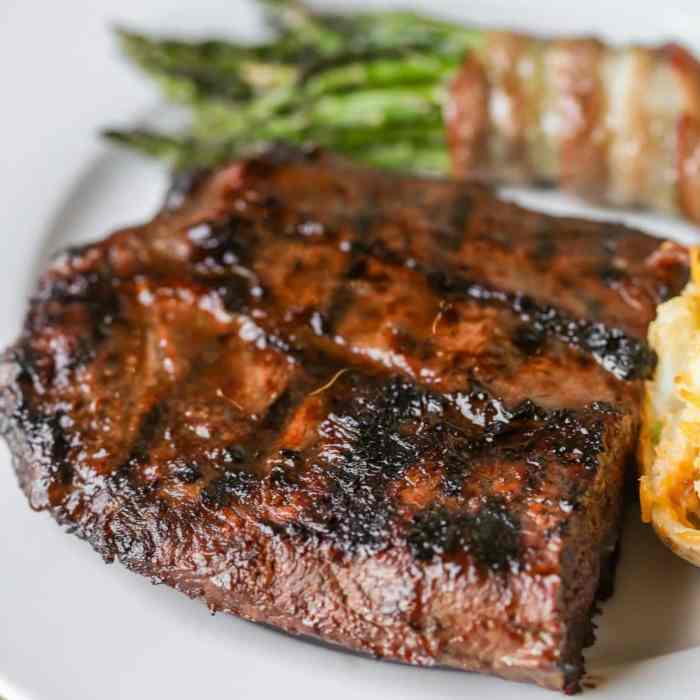
Marinades are a powerful tool for enhancing the flavor and tenderness of steak, but the right cooking method is crucial to fully unlock their potential. Choosing the appropriate cooking technique based on the marinade and desired doneness is essential for a truly satisfying steak experience.
Cooking Methods for Marinated Steak
The cooking method you choose should complement the marinade and the desired level of doneness.
- Grilling:Ideal for steaks marinated in bold, smoky flavors, grilling delivers char marks and a crispy exterior while retaining the juicy interior.
- Pan-Searing:This method works well for steaks marinated in delicate flavors, as it creates a flavorful crust without overcooking the interior.
- Broiling:A quick and efficient method, broiling is suitable for steaks marinated in acidic or herb-based marinades, achieving a crispy exterior and a tender interior.
- Reverse Searing:This technique involves cooking the steak slowly at a low temperature until it reaches the desired doneness, followed by a quick sear to create a flavorful crust. It’s perfect for thick steaks marinated in complex flavors, ensuring even cooking and a tender, juicy result.
Achieving Desired Doneness
Understanding the different levels of doneness is crucial for cooking steak to your liking.
- Rare:The center is cool and red, with a temperature of 125°F (52°C).
- Medium-Rare:The center is warm and pink, with a temperature of 130°F (54°C).
- Medium:The center is warm and pink, with a temperature of 140°F (60°C).
- Medium-Well:The center is slightly pink, with a temperature of 150°F (66°C).
- Well-Done:The center is brown and cooked through, with a temperature of 160°F (71°C).
Maximizing Flavor and Tenderness
To ensure the best results when cooking marinated steak, consider these tips:
- Pat Dry:Before cooking, pat the steak dry with paper towels to prevent steaming and ensure a crispy crust.
- Preheat:Preheat your grill, pan, or oven to the appropriate temperature for the chosen cooking method.
- Don’t Overcrowd:Give the steak enough space in the cooking vessel to ensure even cooking.
- Use a Meat Thermometer:A meat thermometer is the most reliable way to determine the internal temperature of the steak and achieve the desired doneness.
- Rest:After cooking, let the steak rest for 5-10 minutes before slicing. This allows the juices to redistribute, resulting in a more tender and flavorful steak.


